 |
||
|
||
| ||
By Maxim Liadov
Just a short time ago Hoontech wasn't very popular with PC users. But with narrow means and in search of optimal price/quality solutions this company managed to provide their products, in particular, their sound cards with quite attractive characteristics. But Hoontech offers a wide range of other products for PC. In my opinion, all its hardware stuff can be divided into three categories:
You can look at the full range of the Hoontech's products at its site. Hoontech is not at the top in the sphere of professional audio equipment, and its cards are interesting for PC users because of three aspects:
A lower price and a high-quality codec (AKM AK4524) allows using the DSP24 Value card as an internal DAC for high-quality playback of music on a computer. And all other possibilities can be left for home experiments with music and modern program samplers/sequencers. This is how I recommend to use this model from Hoontech. And now I'm starting examination of the card so that you can see why I've made such a conclusion.  The SoundTrack Audio DSP24 Value ships in two versions: a usual one and with an additional card with digital and MIDI inputs/outputs. The second package costs $40 more. And today we will deal with the second version.  Accessories:
ST (SoundTrack) and Audio in the ST Audio DSP24 Value card mean that this product belongs to the currently promoted by Hoontech line of its products for the professional market. They have created a special support site www.staudio.com.  A black PCB with gold-plated connectors has the following elements:
4 gold-plated RCA connectors are 2 inputs and 2 outputs. They serve for the professional-quality AK4524. The fifth connector is a stereo minijack Line Out. A signal from an AC'97 codec is applied to it. An additional codec is designed to operate as a DirectSound device of the Windows so that users can have all advantages of a standard PCI sound card. The daughter card contains coax and optical inputs/outputs. There are also stereo minijack MIDI connectors (adapters for DIN-5 are provided) and an internal CD S/PDIF in.  Look at the circuit of the DSP card, ENVY24 from IC Ensemble:  This chip provides management of the PCI bus in the DMA mode and an independent support of operations with channels coming from the bus to I2S and AC'97. The professional interfaces' part contains 20 channels of up to 24bit with hardware mixing in 36-bit capacity. It allows realizing multi-client drivers for 5 stereo inputs and 5 stereo outputs. The resulting signal can be monitored on a digital-out without any conversions or S/PDIF out can be used without a hardware mixing (pass-through mode). The DirectSound is provided with hardware SRC and digital mixing of 16 streams with parameters not higher than 16bit 48kHz. Both mixers are separate devices. A professional mixer in all Hoontech cards is called Output Mixer, and the one which works under the Windows is named as an Internal Mixer. The MIDI is supported at the level of integrated controllers of the MPU-401 ports. The ENVY24 is an advanced chip which is popular with professional equipment manufacturers. But keep in mind that whether all its possibilities will be enabled depends on a soundcard maker. If drivers do not support something the hardware part wouldn't help. Besides, the number of inputs/outputs on the card also matters. The AKM AK4524VF codec is the same as in the EGOSYS Waveterminal 2496 reference card. The codec's documentation is obscure. It has high characteristics of studio equipment level. But the SoundBlaster Audigy has also specified fantastic 100 dB of SNR. Luckily, theRightMark Audio Analyzer puts all cards in equal test conditions, and now no magic specifications will help. :) Drivers and utilitiesUnfortunately, we couldn't get the provided drivers and utilities work correctly on our test platform: AMD Athlon 1333 / 512 PC 133/ VIA KT133A. The situation was improved by the drivers from the manufacturer's site. However, the drivers supplied with the card had a virtual studio support when you can realize intuitive commutation of the devices with virtual cables (in the style of Reason and other similar programs). The new drivers offer a completely different interface: it is simpler but it works flawlessly.  The manufacturer's site offers drivers for Windows 9x, ME, NT4, W2K and XP. Examination of the drivers and utilities can take a lot of time even for an advanced user. When the drivers are installed under the W98SE the audio properties get a lot of devices for sound recording and reproduction. Int. WaveOut is a device compatible with the DirectSound; it implements playback through the AC'97 codec. For this device there is a standard mixer of the Windows. Ext. WaveOut 1/2...7/8 are 4 virtual devices which realize multi-client support in professional audio applications. S/PDIF Out is a digital S/PDIF output when a daughter card is provided. Multiple PCM Out is something mysterious :) The recording devices have quite clear names, except Digital Mixer. It is a virtual device for organization of an internal digital loopback. It can be useful, for example, for transferring of MIDI tracks to Audio tracks (for example, from GIGAStudio into Cubase. The system tray incorporates a convenient manager of the card's settings. 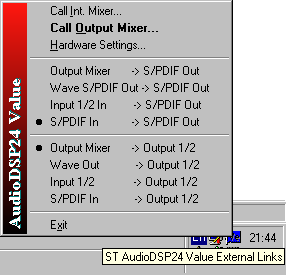 With it you can enable two mixers: internal and external. The first one is not very interesting as it focuses on management of the AC'97 codec. 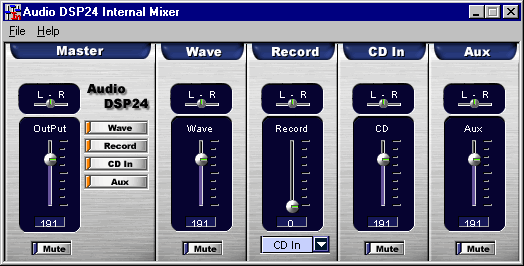 The second one - Output Mixer - is much handier: a volume level is shown in dB; signal level sensors of the channels have a peak indicator. Positions of overloading in a digital mode are lacking - the upper value is 0 dB. Traditional Solo and Mute are here, and unnecessary channels are easy to remove. 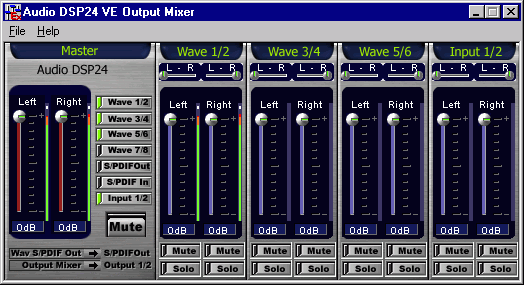 All necessary parameters can be adjusted in the Hardware Settings: 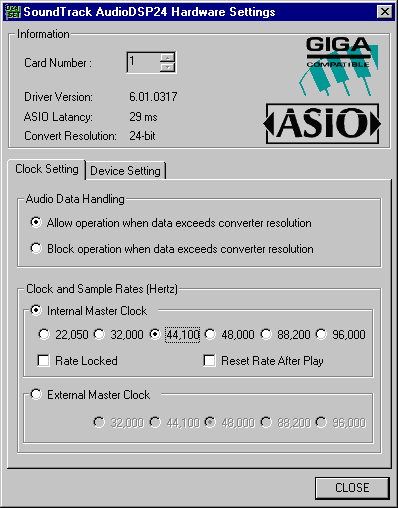 The second tab allows professional audio interfaces to be supported independently by each of virtual outputs. 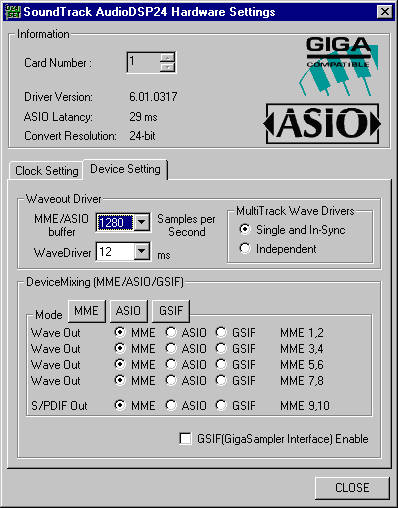 The minimal delay for the ASIO is 5 ms. It provides a flawless operation with 16bit/44.1kHz samples used, for example, in Cubase and Reason. In this mode the card can work in a relatively weak computer. Thus, a P3-550 based get-up with 128 MB memory and with this card easily coped with 10 stereo 16/44 tracks in the Cubase with one or two VST plugins on each track. With the Athlon 1333 and 512 MB memory you can process the same number of tracks but now in 24/96 mode (though you have to provide 2-3 GB on your hard drive for each composition). The card was tested in a real-life when I was working on my CD "4 years of iXBT" and passed the test as a secondary card on a MIDI station. The simultaneously started GIGAStudio 2.20.42 (GSIF), Cubase (ASIO), Reason (ASIO) and Winamp (MME) worked flawlessly. A MIDI port on the daughter card operated correctly with a MIDI keyboard Yamaha CBX-K1. DSP24 Value and W2KAt present a situation with new operating systems such as W2K/XP is not favorable for many professional soundcards. A WDM driver doesn't have some required functions very often; besides, it is permanently in a beta status. The Hoontech DSP24 Value faces the same troubles. Its driver v7.1.0928 Beta5 (11/07/01) for W2K SP2 has neither multi-client support nor GSIF one (the GigaStudio v 2.5 sampler can not find a GSIF-compatible sound device and informs about ERROR 60000). 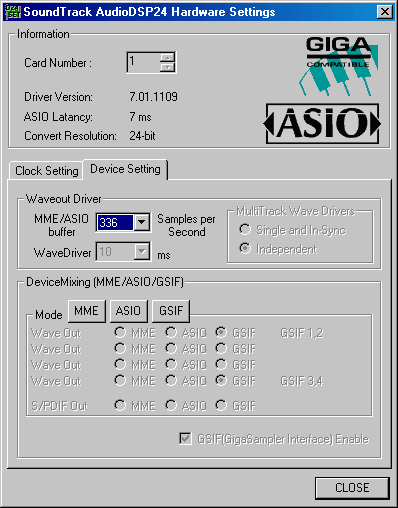
Therefore, the card hardly suits for professional operation in W2K, but will be a good choice for listening to music. By the way, as one can read in the readme file for the W2K driver, Hoontech programmers are currently working on this problem and they promise to solve it in the near future. Unlike the tested card, my EGOSYS Waveterminal with the EWDM driver v.3.0 feels well in the W2K/XP. Multi-client and GigaStudio support is provided, and it has no bugs. Tests of RCA outputsIn the tests we used the RMAA 3.1 program (the official site of the project is audio.rightmark.org). The measurements were carried out in the Windows 98 SE, DX8.0a, IE5.5 SP1. It turned out to be difficult to measure input-to-output characteristics because with such connection and without applying a signal the ST Audio DSP24 Value card entered the mode very similar to self-excitation. That is why we used the time-proved Waveterminal 2496 with 2.41 drivers as a generator and receiver of a signal. For measurements we used TRS-to-RCA cable made of a short-cut microphone low noise OFC cable with metallic gold-plated connectors. 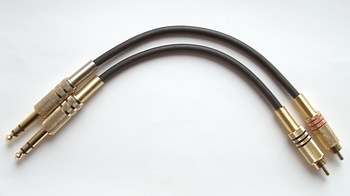 Testing chain: DSP24 Value RCA Out - WT2496 Line In Operating mode: 44100 Hz, 16 bit
General performance: Very good (in detail) In the 16bit 44100 Hz mode the card showed excellent results. The level of THD and intermodulation distortions is the lowest. It indicates high quality of reproduction and lack of resampling which is peculiar to all multimedia cards. On the other hand, a noise level and a dynamic range for the professional AKM codec is less than expected. The further tests will show that it is caused by internal algorithms. Probably, it is resulted from hardware mixing of those 20 channels with unavoidable reduction of the dynamic range and anti-aliasing by dithering. Testing chain: DSP24 Value RCA Out - WT2496 Line In Operating mode: 48000 Hz, 16 bit
General performance: Very good (in detail) In the 16bit/48,000 Hz mode the card has very similar results: the performance is cool, especially considering its price. Testing chain: DSP24 Value RCA Out - WT2496 Line In Operating mode: 96000 Hz, 24 bit
General performance: Very good (in detail) In the 24bit/96000 Hz mode the card behaved uncertain. Despite a high-fidelity testing signal the AFC breaks after 20 kHz. You can notice that the graph drops out because of superposition of harmonics and mistiming of the testing and resulting signals in course of operation of the measuring program. Despite its professional codecs the ST Audio DSP24 Value card suits only for playback of 24bit 96000 Hz records.  Tests of RCA inputsTesting chain: WT2496 Line Out - DSP24 Value Line In Operating mode: 44100 Hz, 16 bit
General performance: Very good (in detail) Quite attractive sampling characteristics in the 16bit 44100 Hz mode lacking for numerous harmonics make this card an excellent purchase for operation in this mode. Testing chain: WT2496 Line Out - DSP24 Value Line In Operating mode: 96000 Hz, 24 bit
General performance: Good (in detail) Take a closer look at the IMD graph. Mirroring of the signal spectrum at 24 kHz indicates at resampling into 48 kHz at a certain stage of signal sampling.  The characteristics at 24bit 96kHz are worse than at 16bit 44.1kHz, that is why I don't recommend to use the ST Audio DSP24 Value card (at least, with current drivers) in this mode. Moreover, when we applied a sinusoid with a frequency over 24 kHz quite noticeable harmonics appeared in the audible spectrum; they reached half of the level of the original amplitude. Test of the S/PDIF OUTTesting chain: DSP24 Value Digital Out - WT2496 Digital In Operating mode: 44100 Hz, 16 bit
General performance: Very good (in detail) Testing chain: DSP24 Value Digital Out - WT2496 Digital In Operating mode: 48000 Hz, 16 bit
The results are rather acceptable for a card of this price range. At 24bit 96kHz the testing in a digital mode failed because of breakup of the synchronization in some tests. Here we can see again mirroring of the spectrum at the half of the resampling frequency, 48 kHz. Comparison with characteristics of Creative Audigy and Egosys WaveterminalLet's compare the Hoontech card with other popular cards to determine its positioning.  Operating mode: 44100 Hz, 16 bit
The DSP24 Value performs much better than the cheaper Audigy, but its noise level prevents it from reaching the more expensive Waveterminal (though it is based on the same codec!) Operating mode: 48000 Hz, 16 bit
The Audigy Rear has caught up with the DSP24 Value and even outscored it as far as a noise level is concerned. But with such a thicken of harmonics the Audigy has a long way to go. Operating mode: 96000 Hz, 24 bit
The situation is the same. The Audigy and DSP24 Value fall far behind the Waveterminal. The Audigy demonstrates mirroring of the signal at a half of the resampling frequency:  Digital output: 44100 Hz, 16 bit
* Output device - S/PDIF Out As far as digital output is concerned the DSP24 Value offers to output a signal from an internal digital mixer or from a separate device S/PDIF Out. The advantages of the latter are well seen from the measurement results. Here the DSP24 Value caught up with the Waveterminal in quality of operation. The identity of the results is accounted for by the fact that both cards use the same chips of digital transmitter and receiver. DSP24 Value and gamesFor compatibility with games and Windows applications Hoontech provided the card with a separate AC'97 codec. What for? The matter is that requirements for a DirectSound-compatible device are opposite to those for a professional ASIO device. When we tried to set WaveOut 1/2 with the sound device in a game the sound was jerky and tardy. Video clips which use ActiveX components of IE run 20 times faster. Voices of heroes in the games are played 2-4 times faster at a frequency different from the sampling one. Developers solve this problem differently; sometimes they enable a special operating mode partially compatible with DirectSound. Let's see what Hoontech offers. Diagnostics of the Minerva v1.08 program: Minerva is testing:
|
Platform · Video · Multimedia · Mobile · Other || About us & Privacy policy · Twitter · Facebook Copyright © Byrds Research & Publishing, Ltd., 1997–2011. All rights reserved. |